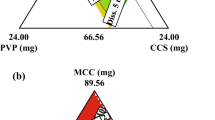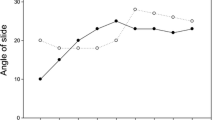Abstract
The objective of this work was to apply artificial neural networks (ANNs) to examine the relative importance of various factors, both formulation and process, governing the in-vitro dissolution from enteric-coated sustained release (SR) minitablets. Input feature selection (IFS) algorithms were used in order to give an estimate of the relative importance of the various formulation and processing variables in determining minitablet dissolution rate. Both forward and backward stepwise algorithms were used as well as genetic algorithms. Networks were subsequently trained using the back propagation algorithm in order to check whether or not the IFS process had correctly located any unimportant inputs. IFS gave consistent rankings for the importance of the various formulation and processing variables in determining the release of drug from minitablets. Consistent ranking was achieved for both indices of the release process; ie, the time taken for release to commence through the enteric coat (Tlag) and that for the drug to diffuse through the SR matrix of the minitablet into the dissolution medium (T90-10). In the case of the Tlag phase, the main coating parameters, along with the original batch blend size and the blend time with lubricant, were found to have most influence. By contrast, with the T90-10 phase, the amounts of matrix forming polymer and direct compression filler were most important. In the subsequent training of the ANNs, removal of inputs regarded as less important led to improved network performance. ANNs were capable of ranking the relative importance of the various formulations and processing variables that influenced the release rate of the drug from minitablets. This could be done for all main stages of the release process. Subsequent training of the ANN verified that removal of less relevant inputs from the training process led to an improved performance from the ANN.
Similar content being viewed by others
References
Jha BK, Tambe SS, Kulkarni BD. Estimating diffusion coefficients of a micellar system using an ANN. J Coloid Interface Sci. 1995;170:392–398.
Bourquin J, Schmidli H, Van Hoogevest P, Leuenberger H. Basic concepts of ANN modeling in the application to pharmaceutical development. Pharm Dev Technol. 1997;2(2):95–109, 111–121.
Erb RJ. Introduction to back propagation NN computing. Pharm Res. 1993;10(2):165–170.
Hussain AS, Yu X, Johnson RD. Application of neural computing in pharmaceutical product development. Pharm Res. 1991;8(10):1248–1252.
Hussain AS, Johnson RD, Vacharajani NN, Ritschel WA. Feasibility of developing an NN for prediction of human pharmacokinetic parameters from animal data. Pharm Res. 1993;10(3):466–469.
Hussain AS, Shivanand P, Johnson RD: Application of neural computing in pharmaceutical product development: computer aided formulation design. Drug Dev Ind Pharm. 1994;20(10):1739–1752.
Chen Y, McCall T, Baichwal A, Meyer M. The application of an ANN and pharmacokinetic simulations in the design of CR dosage forms. J Control Release. 1999;59:33–41.
Ebube NK, McCall T, Chen Y, Meyer M. Relating formulation variables to in vitro dissolution using an ANN. Pharm Dev Technol. 1997;2(3):225–232.
Murtoniemi E, Merkku P, Kinnunen P, Leiviska K, Yliruusi J. Effect of NN topology and training end-point in modeling the fluidised bed granulation process. Int J Pharm. 1994;110:101–108.
Murtoniemi E, Yliruusi J, Kinnunen P, Merkku P, Leiviska K. The advantages by the use of NN in modeling the fluidised bed granulation process. Int J Pharm. 1994;108:155–164.
Turkoglu M, Ozarslan R, Sakr A. ANN analysis of a direct compression tabletting study. Eur J Pharm Biopharm. 1995;41(5):315–322.
Kesavan JG, Peck GE. Pharmaceutical granulation and tablet formulation using NN. Pharm Dev Technol. 1996;1(4):391–404.
Bishop CM. Neural Networks for Pattern Recognition, Oxford, England: Clarendon Press; 1995.
Ledwidge MT, Corrigan OI. Effects of surface active characteristics and solid state forms on the pH solubility profiles of drug-salt systems. Int J Pharm. 1998;174:187–200.
Trajan Software Ltd. Trajan Users Manual. Washington, Tyne and Wear, UK: Trajan Software Ltd; 1999.
Rowe RC, Colbourn EA. Applications of neural computing in formulation. Pharmaceutical Visions. 2002;spring:4–8.
Van der Watt JG. The effect of particle size of microcrystalline cellulose on tablet properties in mixtures with magnesium stearate. Int J Pharm. 1987;36:51–54.
Billany MR, Richards JH. Batch variation of magnesium stearate and its effect on the dissolution rate of salicylic acid from solid dosage forms. Drug Dev Ind Pharm. 1982;8(4):497–511.
Author information
Authors and Affiliations
Corresponding author
Rights and permissions
About this article
Cite this article
Leane, M.M., Cumming, I. & Corrigan, O.I. The use of artificial neural networks for the selection of the most appropriate formulation and processing variables in order to predict the in vitro dissolution of sustained release minitablets. AAPS PharmSciTech 4, 26 (2003). https://doi.org/10.1208/pt040226
Received:
Accepted:
DOI: https://doi.org/10.1208/pt040226




